Scroll to:
Evaluation of Wear Resistance of a Modified Radial Bearing Design Taking into Account Compressibility and Viscosity of the Lubricant
https://doi.org/10.23947/2687-1653-2024-24-4-328-338
EDN: USPXOX
Abstract
Introduction. The challenge problem of the quality of lubricants has led to both large-scale and narrow-focused theoretical and applied studies that relate to the operational properties of lubricants. In particular, the authors of the publications are interested in the interaction of bearing and lubrication, since numerous types of machinery and equipment contain these elements. In the literature, the composites used to strengthen the bearing surface are compared, the most effective compositions are determined, and the advantages and disadvantages of the components are analyzed. Mathematical models have been proposed and tested for some of the processes of the interaction under consideration, and acceptable adequacy has been proved for some of them. However, the improvement of such solutions requires taking into account the specifics of the tribosystem. This issue has been poorly worked out, and the presented article is intended to fill this gap. When evaluating the wear resistance of a radial bearing, the compressibility of a high viscosity lubricant is taken into account.
Materials and Methods. The study was based on the tribocontact scheme, which included the radius of the polymer-coated shaft, the radius of the bearing sleeve, the height of the lubrication groove, and the thickness of the lubricating layer. To create new mathematical models that took into account the compressibility of the lubricant, the authors used three equations: motion of the liquid lubricant, continuity, and state. To verify the model, the results of calculations and laboratory tests were compared. In the experiments, a bearing with a groove to preserve lubrication was used. Its rotation speed, loads and temperature conditions were changed. Friction was measured using traditional methods and modern instruments.
Results. The bearing design was modified to take into account an additional factor — the compressibility of the lubricant. The new model predicted the bearing capacity of the part by 8–10% more accurately, and the coefficient of friction — by 7–9%. Fluctuations in the coefficient of friction up to 45 MPa (equivalent to a five-fold increase in load) were detected and explained. This was due to dynamic changes in the surface contact conditions and the effects of external parameters. Optimal applications of antifriction coatings based on hybrid composite materials were determined. The possibilities of practical use of calculation models of a journal bearing were expanded. Its critically important operational characteristics were evaluated in practice.
Discussion and Conclusion. The scientific research results described in this article make it possible to establish the performance characteristics of the bearing at the design stage. The significant potential of this approach has been identified in terms of increasing the reliability and durability of the studied part, and this seems to be an important step in the development of bearing and lubricant technologies. In the future, the authors intend to study such factors as temperature conditions, dynamic loads, and interaction with various lubricants. This will allow us to improve bearing designs and expand their application areas.
Keywords
For citations:
Bolgova E.A., Mukutadze M.A., Prikhodko V.M., Kolobov I.A. Evaluation of Wear Resistance of a Modified Radial Bearing Design Taking into Account Compressibility and Viscosity of the Lubricant. Advanced Engineering Research (Rostov-on-Don). 2024;24(4):328-338. https://doi.org/10.23947/2687-1653-2024-24-4-328-338. EDN: USPXOX
Introduction. In all sectors of the economy, the efficient functioning of mechanisms requires working with high-quality lubricants. The relevance of this issue stimulates scientific research that concerns the operational properties of lubricants. In particular, the authors of the publications are interested in the interaction of two elements that are present in many types of machines and equipment. It concerns, specifically, bearings and lubricants. Researchers often focus on such a lubricant parameter as compressibility. Mathematical models are built to determine the potential efficiency of lubrication in various bearing operating modes.
When studying lubricants, working oils are considered incompressible, but their volume still varies slightly. The compressibility factor depends on the chemical composition of the oil, its temperature, its pressure level, and contamination with air foam, which can cause cavitation, loss of efficiency, drop of oil pressure, origination of noise and erosion.
Modern lubricants play a significant role in increasing the service life of sliding bearings. Advances in chemistry and materials science have made it possible to create new types of lubricants that significantly reduce friction and wear on the working surfaces of bearing supports, and therefore increase the performance of the mechanism. The effect is provided by hydrocarbons and molybdenum disulfide in the lubricant. The use of such lubricants not only increases the reliability and durability of the supports, but also reduces the costs of maintenance and routine repairs.
Among modern developments in the field of polymer coatings, there are modifications of base materials to improve their tribological characteristics. For this purpose, fillers are introduced into polymers [1], including such solid lubricants as graphite, molybdenum disulfide, or carbon nanotubes [2]. These composites have significantly higher wear resistance and can withstand the effects typical of industrial tribosystems [3]. Such coatings can function without special lubricants, which significantly simplifies the operation of mechanisms and reduces operating costs.
At the design stage, it is critically important to take into account the interaction of various materials and coatings [4], to analyze their operation under the influence of high temperatures and speeds. At the same time, the accuracy of calculating the parameters of wear and interaction of surfaces allows for a significant increase of the reliability and durability of friction units [5]. Paper [6] describes the composite structure, friction and wear characteristics of the antifriction polymer fluoroplastic-containing coating.
Article [7] confirms that the use of rubber powder as a filler for epoxy polymers opens up new possibilities for the creation of highly effective vibration-absorbing composites. The flexibility of the process allows changing the type, content and combination of organomineral ingredients and epoxy compounds. This enables the material properties to be adapted to specific requirements and operating conditions, which in turn helps improve the performance and durability of equipment.
In [8], the problem of determining the nature of defects in fiberglass is considered. The solution [9] is based on the analysis of the Fourier spectra of acoustic emission signals. It is found that interlayer damage to matrices appears and develops in the frequency range of 160–240 kHz. This allows for early diagnostics and prompt elimination of such defects.
The fourfold increase in Young's modulus confirms the significance of using a soft template with modified polydopamine and a dispersion coating [10]. Higher mechanical strength combined with improved thermal conductivity opens up new prospects for the creation of materials capable of withstanding extreme operating conditions.
In [11], the capabilities of polyethylene oxide (PEO) solutions in chloroform are described. A multiple increase in relaxation and stretching time indicates a qualitative change in the behavior of PEO and opens up new prospects for its industrial application. Such changes can improve the mechanical stability of polymer products, expand the range of their use and increase the efficiency of production processes.
As experiment [12] has shown, metal powders in the coating composition improve adhesion with the base material. This helps to avoid peeling and cracking of the coating, which is critical for the durability and reliability of the brake transmission. In [13], it is established that combined coatings can become a mechanical engineering standard — they will be used in highly loaded and critical units.
Based on the results of research [14], it can be concluded that the introduction of antifriction polymer composite coatings with a cold-curing matrix is promising in terms of increasing the reliability and efficiency of industrial equipment.
In [15], a mathematical model for assessing electrophoretic mobility is proposed. It assumes that the presence of a scalable structure of the adsorbed permeable polymer layer does not affect the Poisson-Boltzmann distribution of ions in the double electrical layer.
One of the key approaches is the introduction of various fillers into polymers, including solid lubricants. Such fillers as graphite [16], molybdenum disulfide [17] and carbon nanotubes increase significantly the wear resistance of polymeric materials [18].
In [19], the aging of plasma-polymerized hexamethyldisiloxane coatings was investigated. They were activated by helium or dry air plasma and compared to the aging of plasma-activated silicone elastomer.
Experimental data [20] indicate that the operational properties of the material are determined by the nature of the acoustic emission. And this indicator depends on such variables as the filler concentration and curing temperature.
The theoretical calculation models [21] were visualized. Their accuracy was estimated. For this purpose, the following tribological parameters were compared:
- determined by the results of numerical analysis;
- calculated by adequate regression models obtained experimentally.
The comparison proved the high accuracy of the models — within 9–13%.
For successful application of the above methods, it is necessary to take into account the specifics of each tribosystem. Ignoring these features can lead to unreliable results or a decrease in the effectiveness of the proposed approaches.
It is noted in the literature that the liquid lubricant moving in the working gap contains atmospheric gases, on which compressibility depends. This means that its introduction into the model allows us to more accurately predict the behavior of the lubricant and the efficiency of lubrication in various bearing operating modes. This issue is not described in sufficient detail in the available sources, and the presented research is intended to fill this gap. The authors created and analyzed a mathematical model of a viscous lubricant in a bearing. Moreover, on the surface of the bearing bushing there was a composite coating with fluoroplastic. The modified design of the bearing provided for the presence of a polymer coating with a groove for better distribution of the lubricant, which, in turn, increased the durability of the system. Thus, a method for engineering calculations of the design of a radial plain bearing with a groove in a polymer coating has been developed for the first time. The new solution takes into account the compressibility of the lubricant and allows determining the basic tribotechnical parameters. The research objective is to evaluate the wear resistance of a modified design of a radial plain bearing taking into account the compressibility of a high viscosity lubricant. A high viscosity lubricant is a medium that obeys Newton's law. This dependence describes the flow of numerous oils at temperatures far from the freezing point quite well.
Materials and Methods. The wear resistance of a modified radial bearing design is estimated. Parameter Ω specifies the shaft speed. The surface of the modified bushing remains stationary.
A polar coordinate system is adopted to solve the problem. Its pole is the center of the bushing (Fig. 1).
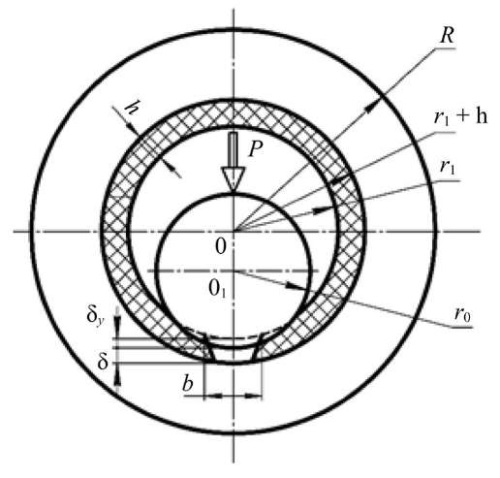
Fig. 1. Tribocontact diagram
In this case, the contours of the shaft, bushing and modified bushing are described in the form:
 (1)
(1)
where r0 — radius of the shaft with a polymer coating; r1 — radius of the bearing bushing;  — groove height; H — thickness of the lubricating layer.
— groove height; H — thickness of the lubricating layer.
The viscosity of the lubricant depends on the pressure:
 (2)
(2)
Here, μ′ — coefficient of dynamic viscosity of the lubricant; μ0 — characteristic viscosity; α′ — constant; ρ′ — hydrodynamic pressure in the lubricating layer; е — eccentricity.
The solution to this problem is based on the equation of liquid lubricant motion, the equation of continuity, and the equation of state:
 (3)
(3)
Here, q — angular coordinate;  ,
,  — components of the velocity vector of the lubricating medium; ρ′ — density (dimensionless quantity).
— components of the velocity vector of the lubricating medium; ρ′ — density (dimensionless quantity).
Boundary conditions for system (3):
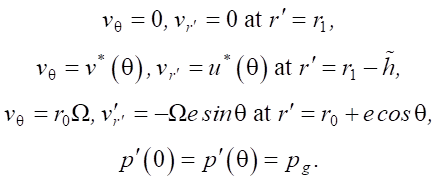 (4)
(4)
Here, pg — lubrication supply pressure; Ω — shaft angular velocity.
We use formula (5) to move to dimensionless variables:
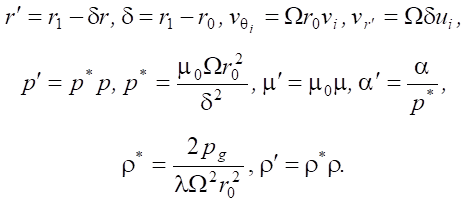 (5)
(5)
Here, u — horizontal component of the velocity; ν — vertical component of the velocity.
As a result of transformations (5) taking into account (3) and (4), we obtain:
 (6)
(6)
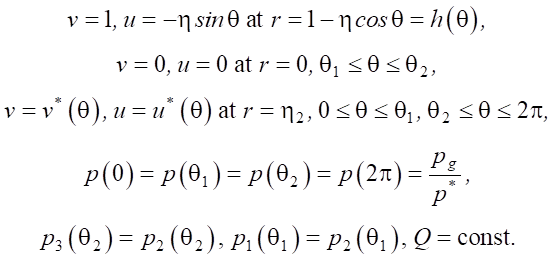 (7)
(7)
Here, η = e / δ — design parameter of a bearing with a standard support profile; η1 = a′ / δ — design parameter of a bearing with an adapted support profile;  — compressibility parameter.
— compressibility parameter.
We introduce z = e–ap. After a series of transformations, we obtain:
 (8)
(8)
Boundary conditions for (8):
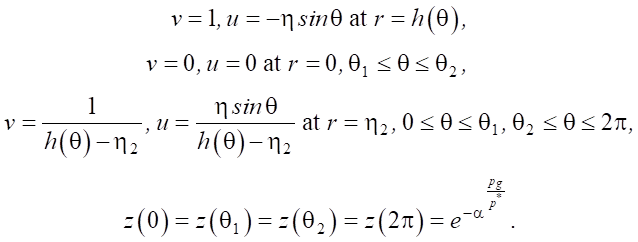 (9)
(9)
Using method [22], we found a self-similar solution to problem (8) taking into account parameters (9):

 (10)
(10)
Here, ψ — function depending on self-similar variable ξ; V, U — components of the velocity field; θ2 — design parameter characterizing the groove depth.
Taking into account (10), equations (8) and boundary conditions (9) take the form:
 (11)
(11)




 (12)
(12)
Taking into account (12) and (13), we obtain the following systems of equations.
For the velocity field:
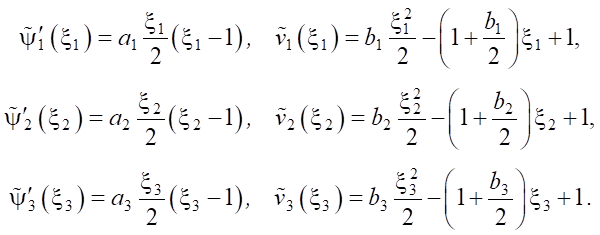 (13)
(13)
For hydrodynamic pressure:





 (14)
(14)
We solve equation (14) using the method of successive approximations, limiting ourselves to two approximations:



 (15)
(15)
To determine the bearing capacity and friction force, we use formula (15):
 ,
,
 ,
,

 (16)
(16)
These studies established the effectiveness of the proposed theoretical model in the specified parameter ranges. The values of compressibility parameter Λ = 0.1–0.9 and stress σ in the range of 9–45 MPa were thoroughly tested to provide the accuracy of the model and the possibility of its wide application.
Experimental Conditions. The research started with the verification of the developed calculation model. For this purpose, numerical calculations were performed, which allowed us to estimate the basic parameters of the bearing operation. The verification included a comparison of these calculation data with the results of laboratory tests. The analysis showed that the calculation model predicted the behavior of the structure with a high degree of accuracy. At the same time, the identified deviations were within the permissible error limits.
Experiments for a bearing with an oil-supporting groove contour were conducted under various operating conditions. In particular, the rotation speed, loads and temperature conditions were changed. The correct selection of mode ensured reduced wear and increased heat generation. This approach allowed for increased reliability and reduced downtime in the operation of mechanisms.
The tests involved traditional methods of measuring friction and wear, as well as modern instrumental approaches. This maintained high measurement accuracy and helped to better understand the mechanisms of friction and wear in the new design.
Research Results. The study allowed us to more accurately represent the performance characteristics of polymer-coated bearings (Table 1). This is of great importance for their effective use in various engineering systems. With the new model, the forecast of data on the bearing capacity turned out to be 8–10% more accurate, and on the friction coefficient — 7–9%.
Table 1
Results of Theoretical Research
|
No |
σ, MPa |
Compressibility parameter |
||||
|
0.5 |
0.4 |
0.3 |
0.2 |
0.1 |
||
|
Friction factor |
||||||
|
1 |
9 |
0.00479000 |
0.00711300 |
0.00310000 |
0.00100000 |
0.00023000 |
|
2 |
18 |
0.00149000 |
0.00149100 |
0.00165300 |
0.00008500 |
0.00049350 |
|
3 |
27 |
0.00017300 |
0.00009200 |
0.00000600 |
0.00005050 |
0.00002700 |
|
4 |
36 |
0.00007500 |
0.00014130 |
0.00000400 |
0.00001160 |
0.00000793 |
|
5 |
45 |
0.00000100 |
0.00001070 |
0.00000100 |
0.00002700 |
0.00000687 |
The experiment showed the presence of fluctuations in the friction factor. This was due to dynamic changes under the conditions of surface contact and the effects of external parameters. Such behavior of the friction factor with increasing load indicated the complexity of interactions in the system, especially considering the maximum recorded load indicator. It reached 45 MPa, which was equivalent to a step increase in load by 5 times (Table 2).
Table 2
Comparison of the Results of Theoretical Research and Experiment
|
No |
Mode |
Friction factor |
|||
|
Theoretical research |
Experiment |
||||
|
σ, MPa |
V, m/s |
Coating |
Considering compressibility |
||
|
1 |
9 |
03 |
0.0105 |
0.0103 |
0.0104 |
|
2 |
18 |
0.3 |
0.0095 |
0.0093 |
0.0094 |
|
3 |
27 |
0.3 |
0.0090 |
0.0088 |
0.0090 |
|
4 |
36 |
0.3 |
0.0085 |
0.0080 |
0.0082 |
|
5 |
45 |
0.3 |
0.0075 |
0.0071 |
0.0074 |
The research results confirm the effectiveness of the developed theoretical models. Their implementation opens up the possibility to significantly increase the load capacity of parts and to considerably reduce the friction factor. The results of the work can be presented as follows.
- The studies of radial plain bearings taking into account the compressibility of liquid lubricant, firstly, showed a significant improvement in their operational characteristics. Secondly, the accuracy of engineering calculations for the bearing capacity increased by 8–10%, and for the friction coefficient — by 7–9%.
- The possibilities of practical use of calculation models of radial plain bearings were significantly expanded. Its critical operational characteristics were assessed in practice.
Discussion and Conclusion. The results of the research described in this article establish the main operational characteristics of the bearing at the design stage. The ability to increase the reliability and durability of the studied part is an important step in the development of bearing and lubricant technologies.
The new method is premised on a theoretical background and has been experimentally confirmed. It is intended for the development of calculation models of radial plain bearings. An important characteristic of the part is an antifriction polymer coating with a groove for retaining the lubricating fluid. The compressibility and rheological properties of the lubricant are taken into account. Considering the previously established parameters of such grooves, a calculation model that describes in detail the behavior of the bearing in the hydrodynamic mode, has been developed. Particular attention is paid to the compressibility of a high viscosity lubricant, whose viscosity parameters depend on the pressure and friction conditions. Recommendations for the use of bearings with optimal grooves have been formulated.
The scope of application of the research results is engineering design and verification calculations when it is necessary to maintain a hydrodynamic lubrication mode. The method is potentially in demand in mechanical engineering, aircraft manufacturing, instrument making, and other industries.
In further research, it seems appropriate to study such factors as temperature conditions, dynamic loads, and interaction with various lubricants. This will allow for the improvement of bearing designs and expansion of their application areas.
References
1. Glushko SP. Investigation of the Electrospark Coating, Alloying and Strengthening Technology. Advanced Engineering Research (Rostov-on-Don). 2021;21(3):253–259. https://doi.org/10.23947/2687-1653-2021-21-3-253-259
2. Tamarkin MA, Tishchenko EhEh, Verchenko AV, Troitskii VM. Formation of Surface Layer Quality under Abrasive Treatment of Polymer-Composite Materials. Advanced Engineering Research (Rostov-on-Don). 2020;20(3):235–242. https://doi.org/10.23947/2687-1653-2020-20-3-235-242
3. Negmatov SS, Abed NS, Saidakhmedov RKh, Ulmasov TU, Grigoriev AYa, Sergienko VP, et al. Research of Viscoelastic and Adhesion-Strength Property and Development of Effective Vibration Absorbing Composite Polymeric Materials and Coatings of Mechanical Engineering Purpose. Plasticheskie massy. 2020;(7–8):32–36. https://doi.org/10.35164/0554-2901-2020-7-8-32-36
4. Pavlycheva EA. Development of Polymer Composition for Obtaining a Protective Coating on Metal Surfaces. International Journal of Applied and Fundamental Research. 2022;(2):33–36. https://doi.org/10.17513/mjpfi.13355
5. Kharlamov PV. Application of the Physico-Chemical Approach to Study the Mechanism of Formation of Secondary Frictional Transfer Structures on the Control Surface. Vestnik RGUPS. 2021;83(3):37–44. https://doi.org/10.46973/0201-727X_2021_3_37
6. Kohanovsky VA, Petroff IA. Friction and Wear of Composites with Polytetrafluorethilene. Vestnik of Don State Technical University. 2009;9(1):30–35.
7. Petukhov DS, Adamov AA, Keller IE. Selection and Identification of a Model of Elasto-Viscoplasticity of the Filled Fluorocomposite according to Free and Constrained Compression Tests. Advanced Engineering Research (Rostov-on-Don). 2022;22(3):180–192. https://doi.org/10.23947/2687-1653-2022-22-3-180-192
8. Bryansky AA, Bashkov OV, Belova IV, Bashkova TI. Investigation of Damages Formed in Polymer Composite Materials under Bending Loading and Their Identification by the Acoustic Emission Technique. Frontier Materials and Technologies. 2022;(2):7–16. https://doi.org/10.18323/2782-4039-2022-2-7-16
9. Shizheng Wen, Si-Dan Zhong, Wei-Qiu Kan, Pu-Su Zhao, Yuan-Chun He. Experimental and Theoretical Investigation on the Hydrochromic Property of Ni(II)-Containing Coordination Polymer with an Inclined 2D→3D Polycatenation Architecture. Journal of Molecular Structure. 2022;1269(12):133753. https://doi.org/10.1016/j.molstruc.2022.133753
10. Liyuan Jin, Wenjing Cao, Pei Wang, Na Song, Peng Ding. Interconnected MXene/Graphene Network Constructed by Soft Template for Multi-Performance Improvement of Polymer Composites. Nano-Micro Letters. 2022;14:133. https://doi.org/10.1007/s40820-022-00877-7
11. Robertson BP, Calabrese MA. Evaporation-Controlled Dripping-onto-Substrate (DoS) Extensional Rheology of Viscoelastic Polymer Solutions. Scientific Reports. 2022;12(1):4697. https://doi.org/10.1038/s41598-022-08448-x
12. Ivanochkin PG, Bolshikh IV, Talakhadze TZ, Bolshikh EP. Application of Antifriction Polymer Composite Coatings in the Brake Lever Transmission of Locomotive. Vestnik RGUPS. 2022;85(1):16–22. https://doi.org/10.46973/0201-727X_2022_1_16
13. Ivanochkin PG, Manturov DS, Danilchenko SA, Karpenko KI. Study on the Effect of the Sealers on the Steel Surface Layer Modified by Electrical Discharge Machining. Solid State Phenomena. 2021;316:713–719. https://doi.org/10.4028/www.scientific.net/SSP.316.713
14. Bryansky AA, Bashkov OV. Identification of Acoustic Emission Sources in a Polymer Composite Material under the Cycle Tension Loading. Frontier Materials and Technologies. 2021;(3):19–27. https://doi.org/10.18323/2073-5073-2021-3-19-27
15. Santanu Saha, Yasuhisa Adachi. Shielding Behavior of Electrokinetic Properties of Polystyrene Latex Particle by the Adsorption of Neutral Poly(ethylene Oxide). Journal of Colloid and Interface Science. 2022;626:930–938. https://doi.org/10.1016/j.jcis.2022.06.154
16. Kohanovsky VA, Kamerova EA. Composites Cover Content Fluor Ethylene in the Liquid Lubricants. Friction & Lubrication in Machines and Mechanisms. 2014;(1):34–37.
17. Kohanovsky VA, Kamerova EA. Friction of the Polymeric Cover in the Liquid Lubricants. Friction & Lubrication in Machines and Mechanisms. 2014;(4):17–20.
18. Kamerova EA, Vlasenko IB, Snezhina NG, Oganesyan PA. Methodology for Studying the Effect of Liquid Media on Fluoroplastic-Containing Antifriction Coatings. Ural'skii nauchnyi vestnik. 2014;100(21);137–142. (In Russ.)
19. Egghe T, Ghobeira R, Morent R, Hoogen-Boom R, De Geyter N. Comparative Study of the Aging Behavior of Plasma Activated Hexamethyldisiloxane-Based Plasma Polymers and Silicone Elastomer Thin Films. Progress in Organic Coatings. 2022;172:107091. https://doi.org/10.1016/j.porgcoat.2022.107091
20. Peng Hu, Ru Xie, Qingyi Xie, Chunfeng Ma, Guangzhao Zhang. Simultaneous Realization of Antifouling, SelfHealing, and Strong Substrate Adhesion via a Bioinspired Self-Stratification Strategy. Chemical Engineering Journal. 2022;449:137875. https://doi.org/10.1016/j.cej.2022.137875
21. Khasyanova DU, Mukutadze MA. The Regularity of Increasing the Wear Resistance of a Modified Radial Slide Bearing. Journal of Machinery Manufacture and Reliability. 2023;(2):71–81. https://doi.org/10.31857/S0235711923010066
22. Kirishchieva VI, Lagunova EO, Mukutadze MA. Increasing the Wear Resistance of the Radial Bearing with a NonStandard Support Profile and Polymer Coating on the Shaft Surface. Vestnik UGATU. 2023;27(2):15–23. https://doi.org/10.54708/19926502_2023_27210015
About the Authors
E. A. BolgovaRussian Federation
Ekaterina A. Bolgova, Postgraduate student of the Higher Mathematics Department
2, Rostovskogo Strelkovogo Polka Narodnogo Opolchenia sq., Rostov-on-Don, 344038
M. A. Mukutadze
Russian Federation
Murman A. Mukutadze, Dr.Sci. (Eng.), Professor, Head of the Higher Mathematics Department
2, Rostovskogo Strelkovogo Polka Narodnogo Opolchenia sq., Rostov-on-Don, 344038
V. M. Prikhodko
Russian Federation
Victor M. Prikhodko, Dr.Sci. (Eng.), Professor, Head of the Descriptive Geometry and Engineering Graphics Department
2, Rostovskogo Strelkovogo Polka Narodnogo Opolchenia sq., Rostov-on-Don, 344038
I. A. Kolobov
Russian Federation
Igor A. Kolobov, Cand.Sci. (Eng.), Associate Professor, Dean of the Transportation Management Faculty
2, Rostovskogo Strelkovogo Polka Narodnogo Opolchenia sq., Rostov-on-Don, 344038
Review
For citations:
Bolgova E.A., Mukutadze M.A., Prikhodko V.M., Kolobov I.A. Evaluation of Wear Resistance of a Modified Radial Bearing Design Taking into Account Compressibility and Viscosity of the Lubricant. Advanced Engineering Research (Rostov-on-Don). 2024;24(4):328-338. https://doi.org/10.23947/2687-1653-2024-24-4-328-338. EDN: USPXOX












































